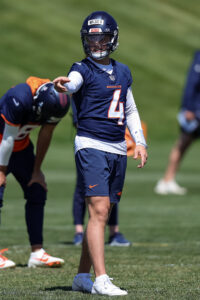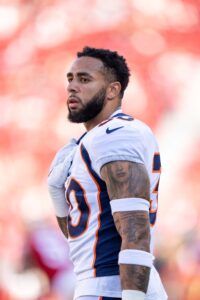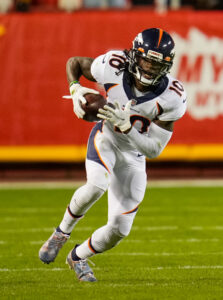Sean Payton has closed the book on his quarterback competition. As expected, Bo Nix will take the reins in Week 1 against the Seahawks. After solid efforts in back-to-back preseason games, the first-round pick can begin preparing with the starters.
 Nix will become the first Broncos rookie QB to start in Week 1 since John Elway in 1983. The conversation will soon shift to a Jarrett Stidham-or-Zach Wilson decision, though the prospect of Denver keeping all three on its 53-man roster has come up as well.
Nix will become the first Broncos rookie QB to start in Week 1 since John Elway in 1983. The conversation will soon shift to a Jarrett Stidham-or-Zach Wilson decision, though the prospect of Denver keeping all three on its 53-man roster has come up as well.
[RELATED: Assessing Broncos’ 2024 Offseason]
This situation has trended toward Nix for a while. A midsummer report pointed to this being the Oregon product’s job to lose, and considering the Broncos drafted a player who set a Division I-FBS record for QB starts (61), it would have surprised if the prospect was not ready to go immediately. Nix impressed in preseason outings against the Colts and Packers, moving the offense toward points on almost every drive he led.
Regularly connecting with Tim Patrick against Green Bay, Nix went 8-for-9 for 80 yards against the Packers’ collection of second-stringers Sunday. Nix led two scoring drives, capping the second with a TD toss to Patrick. In Indianapolis, Nix was 15-for-21 for 125 yards and a touchdown. The rookie, who rushed for 14 touchdowns in 2022 at Oregon, displayed some skills on the ground as well. Payton started Stidham in Indianapolis but gave Nix far more time. Wilson entered third in each game and had not been viewed as a serious contender, even as Payton has praised the former No. 2 overall pick.
Nix joins Jayden Daniels and Caleb Williams among this year’s first-round QB sextet to be named a Week 1 starter. The Patriots have not determined if Drake Maye or Jacoby Brissett will receive the call, though the veteran has long been viewed as the frontrunner. The other two passers chosen in Round 1 will not start to open seasons, with Michael Penix Jr. set to wait behind Kirk Cousins and J.J. McCarthy undergoing knee surgery that will knock him out for the season.
 Payton raved about Nix’s readiness and fit in his offense this offseason, and the rookie consistently made good decisions during his preseason outings. The Broncos were 6-for-7 in scoring drives with Nix taking snaps, and the 6-foot-2 passer threw two short TD passes. Payton informed his trio of QBs after practice Wednesday. Nix is coming off a dominant season at Oregon, having thrown 45 TD passes and three INTs. Though Nix set a Division I-FBS completion percentage record (77.8%), the Broncos attempt to filter out his shorter throws to determine a better prospect value. Payton was satisfied with the result.
Payton raved about Nix’s readiness and fit in his offense this offseason, and the rookie consistently made good decisions during his preseason outings. The Broncos were 6-for-7 in scoring drives with Nix taking snaps, and the 6-foot-2 passer threw two short TD passes. Payton informed his trio of QBs after practice Wednesday. Nix is coming off a dominant season at Oregon, having thrown 45 TD passes and three INTs. Though Nix set a Division I-FBS completion percentage record (77.8%), the Broncos attempt to filter out his shorter throws to determine a better prospect value. Payton was satisfied with the result.
This will set up an interesting decision for the Broncos, as Stidham is in his second year in Payton’s system while Wilson offers more upside. With that upside, of course, comes a history of erratic play with the Jets — to the point the team benched him three times and traded him for a low-end return.
The Broncos would save $5MM by releasing Stidham, who is tied to a two-year, $10MM contract. That deal includes just $1MM in remaining guarantees; a Wilson cut would not create any cap savings. Waiving Wilson would cost Denver $2.7MM, thanks to the salary split the Broncos and Jets agreed to in April. The Broncos chose Zach Wilson as somewhat of a contingency plan, with the trade finalized days before the draft. Following the Russell Wilson debacle, the Broncos were always expected to draft a QB. And Nix-to-Denver rumblings began in February, with Payton guiding a smokescreen effort.
Six-plus months later, Nix is in position to stake his claim to being a long-term Denver starter. The Broncos have endured a maddening run of missteps trying to replace Peyton Manning. This has included some trade misses (Russell Wilson, Joe Flacco, Teddy Bridgewater) and draft shortcomings (Paxton Lynch, Drew Lock).
Payton will be staking his post-New Orleans reputation on Nix, which would have made it borderline shocking if he went with one of the vets early. This will also be new territory for the Super Bowl-winning HC, who has only coached veteran starters (save for a COVID-19-induced Ian Book outing). The Broncos, who are dealing with Russell Wilson’s record-smashing dead money hit for two years, will need Nix to come through as a cost-controlled solution.




